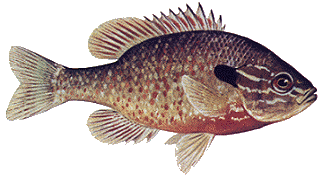Some bluegill feed at the creek inlet for a short time and
then move out of that area. They move to warmer spots along the
north side of the lake, where the spring sun's rays fall for the longest
period during the day, and quickly warm the shallow water there.
That warmer water is not only more comfortable for the fish, it also
causes aquatic vegetation to begin growing, which provides a ready
food supply for the bluegill.
This warm shallow water is a good place to try your Girdle Bugs
and Lightning Bug flies. Use the unweighted styles, cast them near standing
grasses and weeds, and let them sink slowly in the water. A slow retrieve
will work better this early in spring than a fast one, so try to limit it to
short jerks of 4 to 5 inches and pause a few seconds between each jerk.
Fish are extremely nervous at this time of year, so careful, deliberate
wading is essential. Loud noises and sudden movement will drive fish out
of the shallows and may make them so cautious they won't resume feeding
for some time.
Casting along a weed edge is much more productive if you cast
parallel to shore rather than at right angles to it because casts keep the
fly in shallow water throughout the whole retrieve where fish are most
likely to be. Casting toward the weeds and retrieving the fly into deeper
water, allows the fly to be shallow for only a short portion of the cast.
Make your casts as close as possible to the weeds at first, then
progressively work deeper water further from shore until you locate
the fish. Use the countdown method to find the proper depth as you
work your casts slowly into deeper water.
Mother Nature induces fish to feed heavily in the spring as a means
of providing nourishment that will see them through the rigors of the
coming spawn. The female fish needs plenty of food to nourish
thousands of eggs developing in her body, and males have to sock away
some groceries for the hard work of building a nest and defending it and
their offspring from predators.
It isn't long until the water temperature climbs into the high 50's
and low 60's, and the bluegill begin preparations for spawning. Warming
temperatures cause the males to head for shallow water to find suitable
nest sites, while the ladies congregate in deeper water waiting for nest
construction to be completed. A male never seems to be in much of a
hurry to pick a spot - or maybe he is just very particular - but the process
of selecting the right site may take a week or more. During that period he
makes several trips from deep water to shallow each day, apparently
searching for just the right location.
He eventually locates a suitable spot where the bottom is sand or
gravel and he hollows out a depression 12 to 24 inches wide with his tail.
Most often the chosen spot will be in direct light, but it may also be
shaded by trees during parts of the day. Generally a number of bluegill
beds will be found in the same area.
After the bed is formed, the male hovers above it and periodically
sweeps it clean with his tail. When the water temperature rises to about
67 degrees the female moves onto the bed and lays her eggs. The male
fertilizes the eggs and stays at the bed to protect them while the female
drifts back into deeper water. After a short recuperation period she
moves to shallow areas where she feeds on aquatic grasses and weeds
and rests undisturbed while regaining her strength.
The eggs hatch in 2 to 5 days. The male keeps the young fish
corralled in the bed and continues to guard them from predators for
several more days.
Bedding areas can be spotted from the shore, or from a boat, and
finding them is pretty easy if you wear polarized glasses. Some veteran
bluegill fishermen say they can smell a spawning area by walking along
the bank. The smell is distinctive musky, fishy odor and some fishermen's
noses are so sensitive to it they can find a bedding spot as easily as
a pointer can locate a covey of quail. Another method is to watch for
spots where bubbles are caused by gases being released from the lake
bottom when the male fans sand and gravel with his tail are a sure sign of
bluegill activity. ~ Tom Keith
More next time!
|

